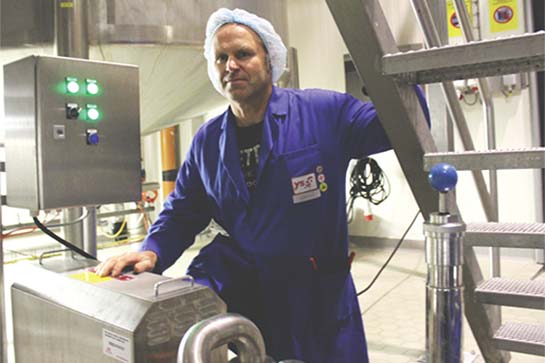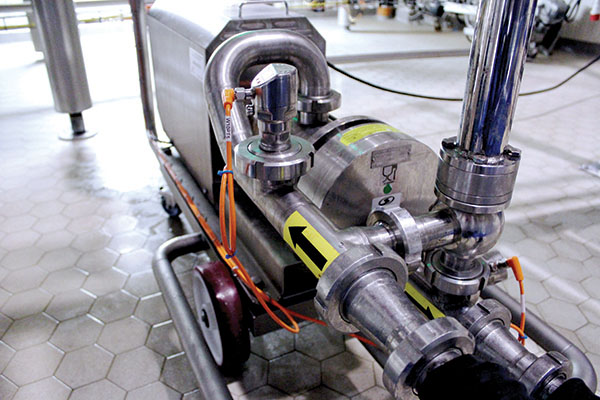Ice cream mixes raise the requirements for volumetrically consistent pumping technology.
Most people are familiar with the 1920s novelty song titled “Ice Cream,” with its instantly recognizable refrain: “I scream, you scream, we all scream for ice cream.” All these years later, consumers still scream for their favorite dessert choice.
There is, however, screaming that is not desirable when it comes to discussing ice cream. These are the howls of frustration that can be heard coming from ice cream manufacturers who are confronted with an underperforming production process that is adversely affecting expected high product quality. Specifically, an inconsistency of flow rate, pressure, and speed when transferring mixes during production could result in the formation of ice crystals that are too large, which compromises the end product’s taste, visual appeal, and creamy sensation.
Ice cream production is actually a relatively straightforward process. An ingredient mix is pumped through a pipeline to a double-wall tube or tunnel freezer that is chilled by liquid ammonia to –22 F (–30 C). Inside the freezer, a slow-turning agitator, or scraper, forces the mix outward, where it briefly touches the frozen outer wall before it is turned back inward. This is when the ice crystals, which eventually become ice cream, are formed.
To achieve the required taste and expected creamy “mouth feel,” the ice cream mix can only spend a highly regulated amount of time in contact with the freezer’s outer wall. This is why the transfer flow and pressure have to be so accurate.

Faced with new recipes that were taxing the efficiency of the centrifugal pumps used in its manufacturing process, Ysco, a producer of private-label ice cream, knew that it needed a better pumping solution. With the help of engineering assistant Krist Levrouw (pictured), the company found a solution with the SLS Series eccentric-disc pump from Mouvex.
“If, during the transfer to the ice cream freezer, the flow is pulsating, then the time the mix spends on the wall isn’t under control,” explained Peter Van de Sompel, manager, Bellux for Spin Pompen, an Assen, The Netherlands-based specialized distributor of pumps and related equipment for use in the food, beverage, and pharmaceutical industries.
“When the flow is constant and optimized to the freezer requirement, then the ice cream coming out of there will have ice crystals that are impossible to detect by the eye and impossible to taste. It should be like a cream and solid at the same time, that’s what makes good ice cream.”
Achieving proper production within the freezer was once relatively easy. That has changed over the years, however, as ice cream has evolved from traditional compositions, such as vanilla, chocolate, and Neapolitan, to much more complicated recipes that can include flavors, nuts, and chunks of fruit or candy.
Mix makeup and viscosity
The combination of a strict manufacturing process and a change in the makeup and viscosity of the ice cream mixes has brought into question the effectiveness of the pumping technology that has been traditionally used in ice cream manufacture, namely centrifugal pumps.

Not only does the SLS Series pump offer the standard features for which Mouvex eccentric-disc pumps have long been recognized, but the design has helped it earn approval from EC 1935/2004, along with 3A, FDA, and EHEDG, for use in food-processing applications.
“The ice cream freezer is very sensitive. It has to be fed with continuous pressure, which has to be maintained in a very narrow range,” said Van de Sompel. “That’s why the centrifugal pump was a good solution. But with higher viscosity you need a volumetric pump with a very stable flow that can be regulated in a very linear way. If you look at that, you need a pump with an equal flow and a 1:1 ratio of flow to speed.”
One company that has mastered the production of ice cream over the years is Ysco, Langemark, Belgium, which, since 1949, has been a major player in the production of private-label ice cream products for retail chains. From its production facilities in Langemark and Argentan, France, Ysco annually produces 41.2 million gallons (174 million liters) of ice cream in the form of 0.26 to 1.3-gallon (1- to 5-liter) tubs, cones, molded and extruded sticks, cakes, and small cups. That volume resulted in sales of more than $244 million (245 million euros) in 2015.
Ysco is part of Milcobel cvba, Kallo, Belgium, a farming cooperative that was formed in 2004 with the merger of BZU Melkaanvoer and Belgomilk. Today the cooperative collects, processes, and commercializes milk from 2,800 dairy farms, and is becoming Belgium’s largest dairy group. Ysco’s ice cream production accounts for 22% of Milcobel’s annual production volume.
The changes in ice cream recipes, however, were beginning to hamper Ysco’s ability to reliably produce finished products that met its demands and those of its customers. Namely, the higher-mix viscosities were incompatible with the operational capabilities of the centrifugal pumps being used to transfer the mix from the preparation vessels, through the pipelines, and into the ice-cream freezers.
That prompted Krist Levrouw, an engineering assistant who has been employed at the Langemark facility for 26 years, to initiate a search for a better pumping solution. “The classic centrifugal pump solution does not work properly with mixes in excess of 500 cP, often as high as 2,500 cP,” said Levrouw. “Under these circumstances, centrifugal pumps are unable to generate the pressure required to transfer the mix and feed the freezer properly. As a result, you can’t empty the vessels completely and you have too much waste.”
Flavor of the day
Some years ago, Ysco’s Argentan facility had begun using C Series eccentric-disc pumps from Mouvex, Auxerre, France, a product brand of PSG, a Dover company, Oakbrook Terrace, IL, USA, for its liquid-transfer operations. In talking to his colleagues at the Argentan plant, Levrouw learned of the success they had been experiencing with the Mouvex pumps, and reached out to Spin Pompen to see if they could suggest a solution for his needs.
“Of course, we knew that the Mouvex technology would solve his problem, which was covering the distance between the tanks and the ice cream generator in a controlled way, with constant flow and no pressure peaks, so that the product characteristics were respected,” added Van de Sompel.
The challenge was considerable because of the layout of the Langemark facility. The supply tanks are located unusually far from the ice cream freezers—720 ft. (220 m)— and that distance was putting additional strain on the centrifugal pumps. “If you’re pumping ice cream over 220 meters you don’t want pulsation, which will cause pressure peaks, which is not very beneficial for the generation of ice cream,” said Van de Sompel.
Addressing these operational challenges, Van de Sompel recommended to Levrouw the seal-less Mouvex SLS Series eccentric-disc pump. SLS Series pumps have been designed specifically for operation in food-and-beverage manufacturing applications. The seal-less design is ideal for hygienic applications because it reduces the risk of product contamination and leaks while avoiding messy spills, waste, and product spoilage.
The stainless-steel pumps feature a design that incorporates a double-wall bellows and pressure-switch monitoring. By mounting the pressure switch on the bellows flange, the bellows become an independent sub-assembly within the pump, resulting in easier and safer operation. The design has helped the SLS pumps get the required certifications from EC 1935/2004, 3A, FDA, and EHEDG, for use in food-processing applications. Because the pump has only two wear parts, maintenance is easy and can be performed while the pump is online.
Along with these advancements, the SLS Series pumps offer benefits for which Mouvex eccentric-disc pumps have long been recognized, including low shear rate, very low pulsation, very low slip, self-priming and dry-run capabilities, exceptional volumetric consistency, repeatability, and clean-in-place (CIP) capability.
“The reality for ice cream manufacturers is that one day they have ice cream mix as milk, then the next day they might have ice cream as thick as 500 cP, up to 2,500 cP,” said Van de Sompel. “The Mouvex pump shows very limited variation in flow rate under varying conditions of pressure and viscosity.”
“The pump is idiot proof, which is very important since we are running 24 hours and everyone has to handle it,” said Levrouw. “If the pump is too difficult to clean and maintain, then it’s a problem. It will be destroyed in a short time. Every step is complicated, but the Mouvex pump makes life easier. No stress.”
Sueli Roel Backes is with the Food & Beverage division of Mouvex, PSG. U.S. headquarters are in Oakbrook Terrace, IL. Backes can be reached at sueli.roel@psgdover.com.